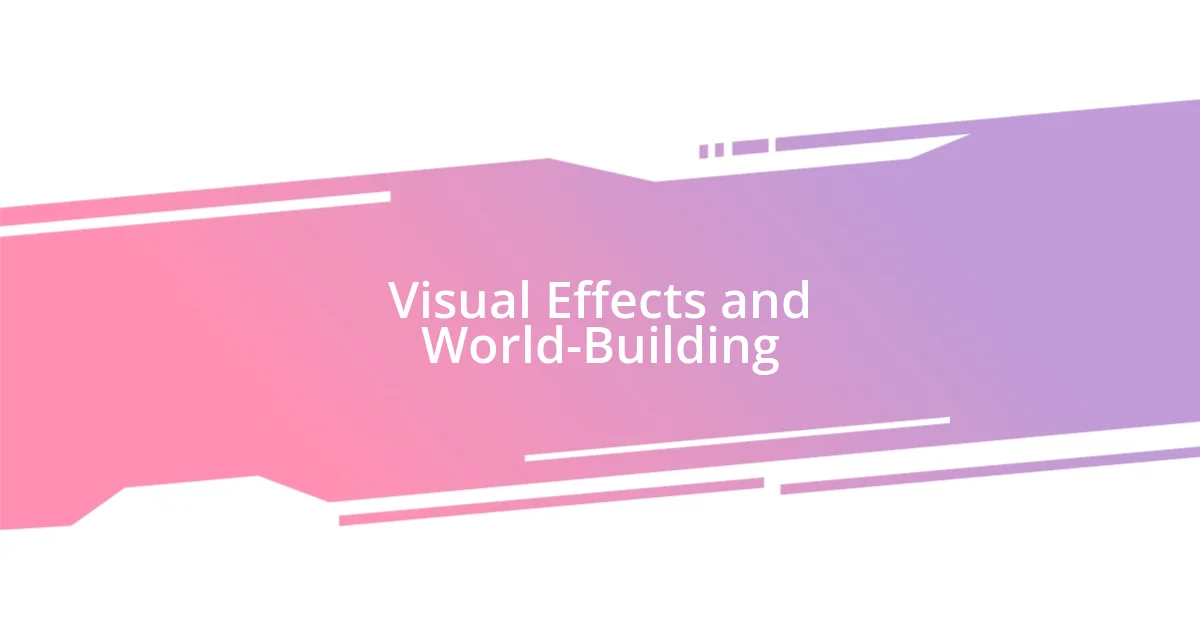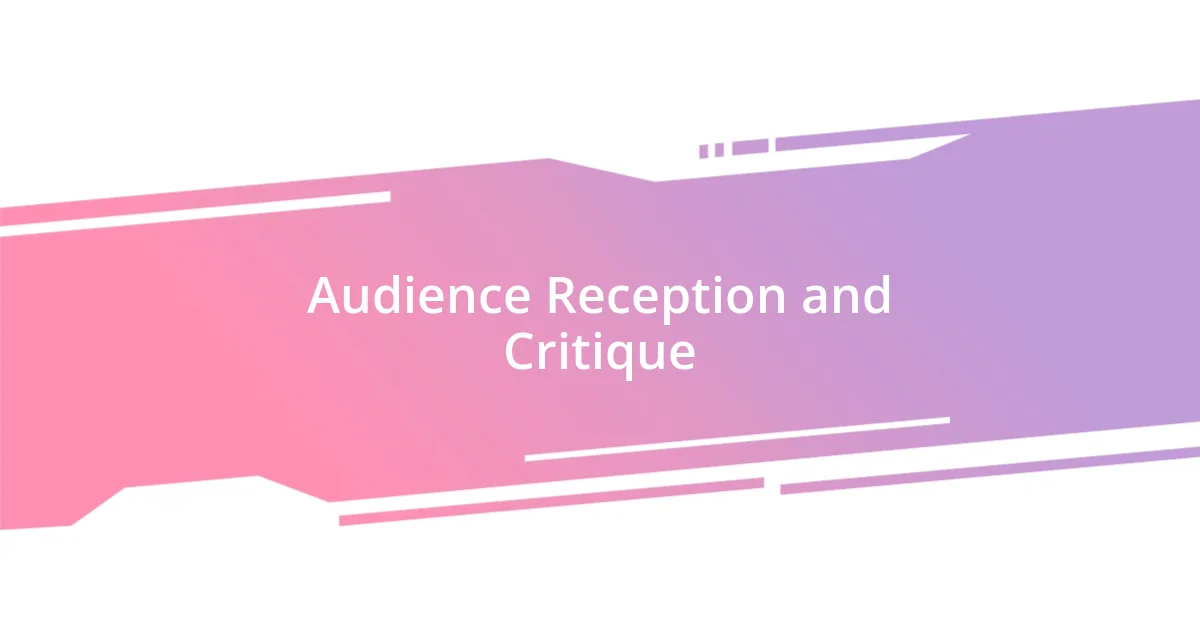Key takeaways:
- Fantasy adaptations balance fidelity to the source material with creative reinterpretation, impacting audience expectations and emotional connections.
- Character development and visual storytelling are crucial in adaptations, influencing how viewers engage with and feel about the narrative.
- Emerging trends include darker themes, diverse perspectives, and interactive storytelling, enhancing the depth and engagement of fantasy narratives.

Understanding Fantasy Adaptations
Fantasy adaptations breathe new life into beloved stories, transforming the written word into visually stunning experiences. Personally, I remember watching the first adaptation of a novel I adored; the thrill of seeing characters and worlds I had imagined come to life was nearly overwhelming. It made me reflect—how do these adaptations capture the essence of the original while still offering something new?
Exploring the intricacies of these adaptations reveals a complex dance between fidelity to the source material and creative reinterpretation. For instance, I often wonder how a director decides which scenes are essential to the narrative. In one of my favorite series, pivotal moments were omitted, yet the adaptation still managed to evoke the same feelings of wonder and excitement I found in the pages of the book.
Each adaptation carries the weight of expectation from fans, which can be both a blessing and a curse. I remember feeling a mix of anticipation and anxiety before watching an adaptation of a classic I cherished. It made me think—how much change can fans endure before the original magic fades? This delicate balance of honoring tradition while introducing innovative storytelling is what keeps the conversation around fantasy adaptations alive and ever-evolving.

Importance of Faithfulness to Source
Faithfulness to the source material is crucial in fantasy adaptations, as it helps maintain the integrity of the story. When I think about a beloved book series like “Harry Potter,” I remember how each character’s quirks and the world-building details made the reading experience so rich. Losing even a single element can shift the entire perception of the story. For fans, those details aren’t just facts; they’re emotional touchstones tied to cherished memories.
Adapting a story also involves understanding what makes it resonate with its audience. I recall eagerly discussing the changes in the adaptation of “The Lord of the Rings” with friends. While some felt that certain scenes captured the spirit of the original beautifully, others lamented the absence of key moments. This reaction underscores how fidelity connects deeply with our expectations and emotional experiences. In essence, fans often feel a personal connection, which makes deviations feel like a betrayal.
Moreover, adaptations that stray too far might alienate dedicated followers while trying to attract new audiences. There was a time when I felt genuinely frustrated after watching a series that diverted from the source completely, leaving me feeling unfulfilled. The balance between creativity and respect for the original narrative is a complex and often tricky path. If the heart of the story is preserved, the adaptation can still create a sense of wonder.
| Aspects | Faithful Adaptation | Unfaithful Adaptation |
|---|---|---|
| Email and community | Drives fan engagement | Causes division among fans |
| Character portrayal | Enhances emotional connection | Could lead to confusion or disinterest |
| Story arcs | Preserves core themes | May undermine the original message |

Evaluating Character Development in Adaptations
Character development is a pivotal element in any adaptation, as it often dictates how audiences connect with the story on an emotional level. I remember watching an adaptation where a character I loved was portrayed differently than I expected. Initially, I felt disappointed, but as the story progressed, I found that this new interpretation offered an intriguing depth to their journey. It pushed me to reassess my understanding of the character’s motivations, ultimately enriching my experience.
When evaluating character development in adaptations, it’s essential to consider the following aspects:
- Depth of Backstory: Delving into a character’s history can create empathy. I once saw a character’s tragic past woven into the plot, leading to a profound emotional response.
- Consistency: Characters need to evolve naturally. I’ve appreciated adaptations that allow character growth while staying true to their fundamental traits.
- Relationships: The dynamics between characters often shape the narrative. A shift in how characters interact can either enhance or detract from their relationships, sparking debates among fans.
- Emotional Resonance: I’ve found that an adaptation either hits home or misses the mark based on how well it conveys a character’s internal struggles and triumphs.
While adaptability is vital in storytelling, striking the right balance can significantly influence the audience’s attachment to characters integral to the original narrative.

Visual Effects and World-Building
World-building in fantasy adaptations has a unique power; it breathes life into realms that once existed solely in our imaginations. I remember watching a series where the detailed landscapes and intricate cultures made me feel like I was truly part of that universe. Those visual effects weren’t just eye candy; they were essential in creating an immersive experience. Without that, could any adaptation really do justice to the original material? I doubt it.
While the visuals can indeed dazzle, they must weave seamlessly into the narrative. I’ve often found myself torn between being impressed with how a fantastical creature was brought to life and feeling that it overshadowed the story’s essence. For instance, I once saw a fantastic dragon in a show that was stunning but barely related to the plot. This raises a question: are we focusing on bringing visuals to life at the expense of character and story development? I believe that grounding those effects in meaningful storytelling is crucial.
Ultimately, it’s the synergy between world-building and visual effects that shapes our perceptions of these adaptations. I recall a film where the creators expertly blended stunning visuals with nuanced storytelling, creating a profound sense of wonder. Each scene felt purposeful and connected, inviting me to explore the universe further. It’s in these moments that I feel the magic of adaptation, transcending the page and enveloping me in a fantastical journey that feels just right.

Audience Reception and Critique
When it comes to audience reception, I’ve noticed that reactions can vary dramatically from one adaptation to another. For instance, after watching a well-loved series turn into a film, I was surprised by how divided my friends were. Some loved the new visuals but felt the essence of the story was lost, while others embraced the fresh take. Have you ever felt that tension between nostalgia and innovation? It’s fascinating how differing viewpoints on adaptations often spark heated debates among fans.
Critiques of fantasy adaptations often highlight the changes made to beloved source material, sometimes overshadowing the actual execution. I remember being part of an online discussion about a popular adaptation where fans expressed their frustration over deviations from the plot. A fellow viewer shared how these changes, although disappointing, opened the door for new interpretations and conversations about the characters. The ability of adaptations to evoke such passionate responses makes me wonder: can change ever be truly detrimental if it keeps the conversation alive?
Ultimately, the way audiences receive and critique these adaptations creates a dynamic relationship between filmmakers and fans. I’ve found that when a project genuinely resonates with its audience, it often leads to a sense of community, as fans rally together to celebrate or critique the choices made. Reflecting on my own experiences, I can say that many productions have left me feeling deeply connected to the characters, even when they took unexpected turns. Isn’t that the beauty of storytelling—where every adaptation can tell us something new, even if it deviates from the original?

Future Trends in Fantasy Adaptations
Looking ahead, I see a rising trend towards darker, more nuanced storytelling within fantasy adaptations. I’ve noticed that studios are beginning to embrace complex narratives that explore themes like morality and power dynamics—areas often glossed over in earlier adaptations. For instance, my experience with a recent series that tackled the moral ambiguity of its heroes left me questioning my own notions of right and wrong. Isn’t it intriguing how a well-crafted story can reflect our reality while still being rooted in fantasy?
Moreover, the increasing use of diverse voices and perspectives is exhilarating. Having experienced adaptations that showcased varied cultural backgrounds enriched the storyline in ways I didn’t expect. I recall watching a show where the cultural nuances added depth to the characters, making their journeys relatable and grounded. This inclusivity is crucial, as it broadens the scope of storytelling and invites everyone to see themselves in these fantastical worlds.
Finally, the integration of interactive storytelling through technology is something I’m keenly watching. The potential for viewers to engage with the narrative through choices or virtual reality is fascinating. I imagine a world where I can navigate a fantasy realm, influencing the story’s outcome based on my decisions—how thrilling would that be? As adaptations evolve, I believe this blend of technology and storytelling will create immersive experiences that deepen our connection to the narrative. It makes me ponder: how might these innovations shape our understanding of fantasy itself?

Personal Reflection and Insights
Reflecting on my experiences with fantasy adaptations, I often find myself pondering the delicate balance between fidelity to source material and creative freedom. I vividly recall watching a beloved book series transform into a film, and as I sat in the theater, I felt a strange mix of excitement and dread. Do you remember that feeling when you hold your breath, not knowing whether the filmmakers will honor the magic of the original? That emotional investment is what makes these adaptations resonate so deeply with many of us.
Another insight I’ve gained is the power of visual storytelling in bringing fantastical worlds to life. I remember one particular adaptation where the visuals were so stunning that, despite some narrative flaws, I was completely captivated. The vivid landscapes and enchanting creatures pulled me into the narrative, almost like a spell. Isn’t it amazing how art can create an immersive experience that can sometimes override our qualms about the plot? It’s a testament to the platform’s ability to transport us.
Ultimately, these adaptations often leave me with a sense of nostalgia combined with hope for future narratives. When I look back at the characters that have shaped my perception of fantasy, I can’t help but feel grateful for the diverse interpretations they’ve inspired. Have you ever felt that warmth of remembering how a character once influenced your dreams and aspirations? This reflection reminds me that every adaptation, for better or worse, contributes to the evolving landscape of storytelling.












